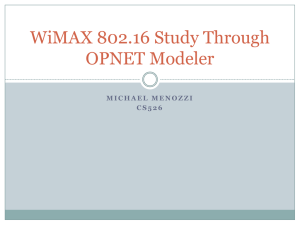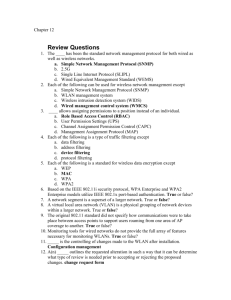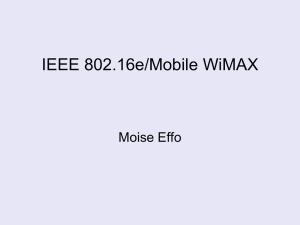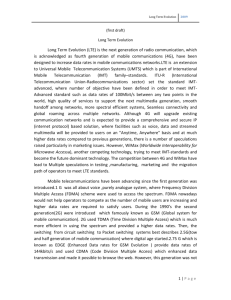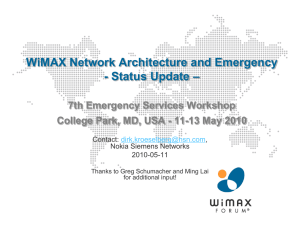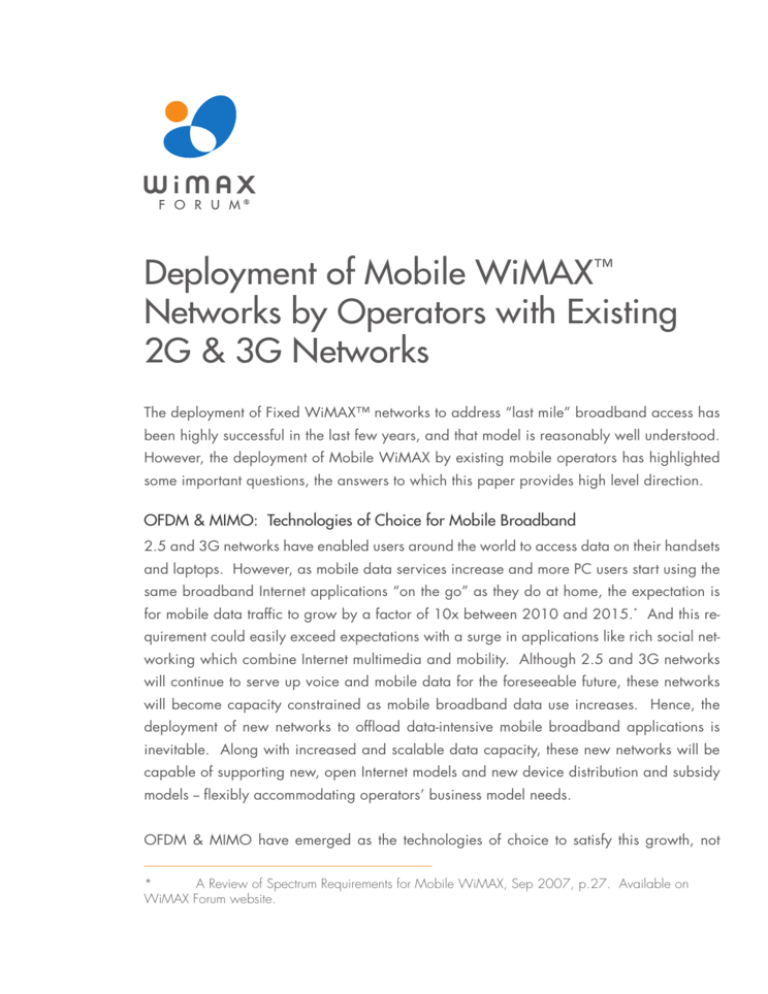
Deployment of Mobile WiMAX™
Networks by Operators with Existing
2G & 3G Networks
The deployment of Fixed WiMAX™ networks to address “last mile” broadband access has
been highly successful in the last few years, and that model is reasonably well understood.
However, the deployment of Mobile WiMAX by existing mobile operators has highlighted
some important questions, the answers to which this paper provides high level direction.
OFDM & MIMO: Technologies of Choice for Mobile Broadband
2.5 and 3G networks have enabled users around the world to access data on their handsets
and laptops. However, as mobile data services increase and more PC users start using the
same broadband Internet applications “on the go” as they do at home, the expectation is
for mobile data traffic to grow by a factor of 10x between 2010 and 2015.* And this requirement could easily exceed expectations with a surge in applications like rich social networking which combine Internet multimedia and mobility. Although 2.5 and 3G networks
will continue to serve up voice and mobile data for the foreseeable future, these networks
will become capacity constrained as mobile broadband data use increases. Hence, the
deployment of new networks to offload data-intensive mobile broadband applications is
inevitable. Along with increased and scalable data capacity, these new networks will be
capable of supporting new, open Internet models and new device distribution and subsidy
models -- flexibly accommodating operators’ business model needs.
OFDM & MIMO have emerged as the technologies of choice to satisfy this growth, not
*
A Review of Spectrum Requirements for Mobile WiMAX, Sep 2007, p.27. Available on
WiMAX Forum website.
Deployment of Mobile WiMAX™ Networks by Operators with Existing 2G & 3G Networks
only for WiMAX, but also for 3GPP’s future LTE** standard as well as Wi-Fi (802.11n). The
combination of OFDM and MIMO is highly scalable and systems based upon it are best
positioned to satisfy the headroom requirements for mobile broadband data over the next
decade.
In 2007, commercial Mobile WiMAX Release 1.0 systems which have not yet incorporated
MIMO capability, showed a consistent 3x capacity improvement over other mobile wireless
solutions in the same amount of spectrum. And that’s just the start. In 2008, MIMO-enabled
WiMAX systems are expected to deliver 50% gains over the current SISO implementations.
In 2010, wider channel bandwidth support in Release 1.5 will enable peak data rates well
in excess of 100 Mbps using 20 MHz channels. In the future, when equipment can cost
effectively support 4x4 MIMO configurations, peak data rates of over 300 Mbps will be
achievable.***
WiMAX as a Data Overlay to Existing 2G & 3G Networks
Figure 1
Pre OFDM & MIMO
1G
OFDM & MIMO
802.16d
802.16e
802.11a/b
802.11g
802.11n
2G
3G
802.16m
WiMAX
WiFi
LTE
Cellular
All roads lead to OFDM & MIMO. Mobile WiMAX (802.16e) is already there.
WiMAX, 2G & 3G are complementary. The circuit-switched voice offered by 2G & 3G
networks is highly efficient and the coverage level of many of these networks is excellent.
**
3GPP’s Long Term Evolution (LTE) as well as 3GPP2’s Ultra Mobile Broadband (UMB) technologies are based upon OFDM & MIMO. The LTE standard is under development in 3GPP.
***
Using 20 MHz channels and WiMAX Release 2.0. Based upon IEEE 802.16m Systems
Requirement Document.
FORUM
®
2
Deployment of Mobile WiMAX™ Networks by Operators with Existing 2G & 3G Networks
New, data-optimized networks based upon OFDMA**** & MIMO (e.g., today’s WiMAX or
3GPP’s future LTE) will be deployed in entirely new spectrum, and will take years to reach
the coverage levels of today’s 2G & 3G networks. These combined factors point towards
operators maintaining their existing 2G & 3G networks for voice & narrower-band data,
and deploying WiMAX for more data intensive applications. This is precisely what KT is doing with HSPA + Wibro and EV-DO + Wibro; likewise Sprint is planning EV-DO + WiMAX
handsets. Operators will offer multi-mode handsets & modems to provide the best of both
worlds -- coverage + high speed -- to their subscribers while they build out their 4G networks
over several years. For portable devices such as laptops, the multi-mode combination of
Wi-Fi + WiMAX will be the more common embedded solution for ensuring coverage.
The Migration Path to 4G (OFDMA-MIMO)
Figure 2
WiMAX as a Data Overlay to Existing 2G & 3G Networks
Existing 2G, 2.5G or 3G network
Overlay = OFDMA-MIMO (WiMAX)
2/2.5G Operator, no 3G
investment
When EDGE capacity insuffinient, deploy OFDM
overlay solution in new spectrum
3G Operator - HSPA, EVDO
Continue to evolve HSPA, EV-DO in existing spectrum; OFDM overlay in new spectrum
Fixed/Non-Cellular Operator (PTT, Satellite, Cable)
Go straight to OFDM deployment
Operator retains 2G or 3G network - Overlays data network
****
The variant of OFDM used by both WiMAX & LTE.
FORUM
®
3
Deployment of Mobile WiMAX™ Networks by Operators with Existing 2G & 3G Networks
The 3G evolution from WCDMA to HSPA or equivalently, CDMA2000 to EV-DO -- all
technologies based upon CDMA -- was achieved via upgrades to operators’ existing 3G
networks utilizing the same spectrum. These upgrades will continue, but fundamentally
these networks do not have the scaling capability to address future data traffic patterns
associated with mobile broadband use. (Higher order MIMO antenna configurations are
the core enabler for scaling throughput of OFDM/MIMO systems over the next decade, but
CDMA support for higher order MIMO is not efficient. For this reason, IEEE 802.16, 3GPP
and 3GPP2 standards bodies are all adopting OFDM & MIMO for 4G.) Since there is no
expectation to decommission operational 2G & 3G networks, new OFDMA-MIMO data
overlay networks -- be they WiMAX today or, in the future, LTE -- must be deployed in new
spectrum, preferably spectrum offering wider swaths of spectrum to enable very high data
capacity.
The addition of an OFDMA-MIMO mobile broadband data overlay network involves deployment of new base station line cards and clients as well as upgrades to the core network
to support high amounts of IP (Internet Protocol) traffic. That said, existing mobile operators
can co-locate WiMAX base station equipment in their existing 2G or 3G cell sites. In mobile
WiMAX commercial deployments to date, we have seen a cell site re-use rate of 70%*****.
Once the data overlay network is in place, operators may offer multi-mode devices as it
makes sense to enable seamless roaming across their voice-optimized and data-optimized
networks as mentioned earlier. The WiMAX community has and will continue to work
closely within 3GPP to optimize interworking between WiMAX & 2G / 3G networks. The
open network architecture supported by WiMAX may create healthy competition for certain
common network elements -- potentially increasing innovation and reducing costs.
We have found operators very supportive of WiMAX-3GPP interworking as it creates a
safe, viable choice in WiMAX for their 4G technology decision.
From Standards Completion to Interoperable Products Available Today
Operators which choose WiMAX will benefit for a plethora of innovative, cost effective devices. The mobile WiMAX standard was ratified by IEEE in December 2005. The WiMAX
Forum has held five plugfests since July 2006, with over three dozen equipment vendors
participating in the most recent October 2007 plugfest. WiMAX Forum mobile certification
***** Approximate rate of re-use of EV-DO sites in KT Wibro network.
FORUM
®
4
Deployment of Mobile WiMAX™ Networks by Operators with Existing 2G & 3G Networks
Figure 3
2G, 3G Radio Access Network
2G, 3G Core Network
(RAN) (GSM, EV-DO, HSPA)
SGSN
MGW
GGSN
Upgrade core network to support
more IP data traffic
New 4G Data Overlay Network
New 3GPP All IP Core
WiMAX or LTE (OFDMA-MIMO)
S-GW/P-GW
Radio Access Network (RAN)
HSS
MME
OCS/OFCS
PCRF
Core Network
As a data overlay network, WiMAX will interface the new 3GPP Enhanced Packet Core.
began in Jan 2007 and, in anticipation of the submission of hundreds of devices, the Forum
has opened five labs: 3 in Asia Pacific, 1 in the U.S. and 1 in Europe.
In the first major commercial mobile WiMAX deployments, we are already seeing an unprecedented level of device innovation: WiMAX USB dongles with integrated MP3 and
mobile TV, tri-mode (WiMAX, 3G & T-DMB) smartphones and multi-mode (Wi-Fi, WiMAX,
Bluetooth) mobile Internet devices and notebooks.
Expected to further accelerate device & application innovation as well as price/performance metrics, Taiwan launched its M-Taiwan initiative involving dozens of component,
equipment, content, application & service providers with over $1.2 billion USD in planned
investment. The recent awarding of WiMAX spectrum licenses in Japan should also produce exciting advancements given that country’s historical leadership in driving innovative
wireless devices and applications.
Net-net: A global industrial complex is in process of delivering the economies of scale of
the Internet & PC industry to the mobile broadband arena via WiMAX. WiMAX Forum
membership includes some of the world’s largest mobile & wireline operators and virtually
every major global telecom equipment manufacturer. Complementing these members are
FORUM
®
5
Deployment of Mobile WiMAX™ Networks by Operators with Existing 2G & 3G Networks
hundreds of smaller, highly focused application, content & service providers, equipment
manufacturers and component makers ensuring supplier support and a variety of applications and devices whether a WiMAX deployment involves 20 or 20,000 base stations.
Summary
For operators with existing 2G or 3G networks, Mobile WiMAX presents a safe and viable
complementary data solution backed by a vibrant, globally competitive manufacturing ecosystem.
Examples of Multi-mode Mobile WiMAX Devices from KT Wibro Deployment
KWD-U1100
WiBro + T-DMB
(mobile TV) DBDM
Samsung: SPH-P9200
LG-KU1P
WiBro + MP3 player
Samsung PDA: SPH-M8200
WiBro, WiFi
Triple mode (WiBro, EVDO, T-DMB)
Voice call thru CDMA
EVERUN 60H/S6S
LGE PDA: LG-KC1
WiBro, 802.11b/g, Bluetooth 2.0
Triple mode (WiBro, EVDO, T-DMB)
Voice call thru CDMA
Samsung: NT-Q35
WiBro, T-DMB
Option (WiFi + Bluetooth 2.0 EDR)
PMP: KWS-P1000
WiBro, T-DMB, video player, MP3
Full internet
Copyright 2008 WiMAX Forum. All rights reserved. “WiMAX”, “Mobile WiMAX,” “Fixed WiMAX,” “WiMAX Forum,” “WiMAX Forum Certified,”
and the WiMAX Forum and WiMAX Forum Certified logos are trademarks of the WiMAX Forum. All other trademarks are the properties of their
respective owners.


